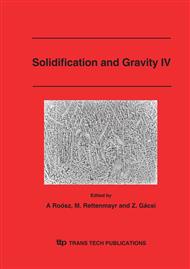p.81
p.87
p.93
p.99
p.105
p.111
p.117
p.125
p.131
Three-Dimensional Single Crystal Morphologies of Diffusion Limited Growth in Experiments and Phase Field Simulations
Abstract:
In growth experiments for 3D xenon crystals we have observed three different morphologies: dendrites, doublons and seaweed. The 3D shape of dendrites and doublons is reconstructed by means of refractive reconstruction. Our measurements on the fin thickness of dendrites support the validity of analytical predictions by Brener. We have found that the fins of the doublon morphology can be fitted with the fin predictions for dendrites. Measurements of the doublon gap as a function of the supercooling show that the gap decreases hyperbolically with increasing supercooling. Phase field simulations of 3D doublons reveal that the channel shows an inner structure in the presence of anisotropy of surface tension. A combination of reconstructions and phase field simulations leads to a geometrical description of doublon cross sections.
Info:
Periodical:
Pages:
105-110
Citation:
Online since:
March 2006
Authors:
Keywords:
Price:
Сopyright:
© 2006 Trans Tech Publications Ltd. All Rights Reserved
Share:
Citation:


